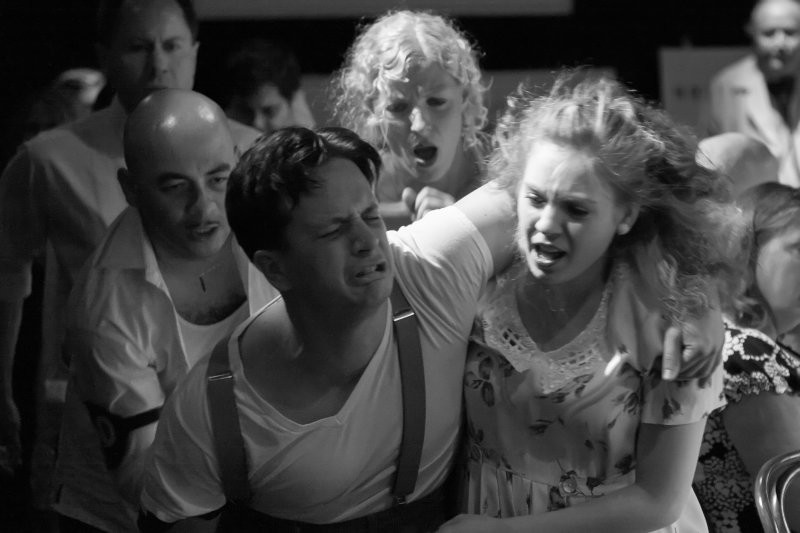The very first dance marathon was held in 1909 in the USA. As many as 170 couples took part in it, and after a full 15 hours only three couples remained. At that moment, the local sheriff could no longer stand it: he stopped the marathon. And even the Great Depression did not stop people from wanting to dance. 
And the total craze for such marathons began in the 1920s, when relatively normal times arrived. The First World War was already over, people had enough jobs and the future seemed quite real and optimistic. It was not for nothing that this time was called the “Roaring Twenties” - attractions, theaters and dance floors grew like mushrooms after rain.
The return of the Olympic Games also played a role, when spectators enthusiastically watched the athletes and wanted to set some kind of record themselves.
Everyone needed that period to breathe out, to forget about the horror they had experienced, at least for a few hours. 
Alma Cummings
1923 The first was Alma Cummings, a dance instructor, when she waltzed for 27 hours without a break at the Audubon Ballroom Marathon (New York), changing as many as six partners. Yes, no one could withstand her pace and match her endurance. Cummings demonstrated what the human body can do and many wanted to repeat Alma's recor. And not just repeat, but also beat him: 9 times throughout the country, couples managed to outdo the 32-year-old dancer. This is how dance marathons started. 
US businessmen quickly realized that this was simply a goldmine for making money: those who wanted to watch began to pay for admission, and the winners began to fight not only for fame, but also for a cash prize. The marathons lasted for many hours and were broken up with all sorts of entertaining performances. Just like that, ordinary entertainment has become an industry.
At marathons, rules appeared regarding not only the dancing itself, but also washing, eating, sleeping... Sometimes couples even registered and when one participant, exhausted, fell off the dance floor, the second was disqualified. In a number of marathons, you were allowed to find a partner immediately from among those willing.
But the main principle of all dance marathons was the same throughout the country: don’t stop. Every hour the dancers were given a 15-minute break and nurses provided assistance if necessary - usually stretching their legs.
They could eat once a day, and the participants washed their faces while dancing. Often partners dozed off during the dance, while one supported the sleepy one - if the knees touched the floor, the couple automatically dropped out.
Dance marathons had another name: “callus carnivals.” And the popularity of such “carnivals” grew at a crazy speed. Almost every city in America with more than 50 thousand people took part in at least one marathon. 
1929 The stock market crashed. In 1931, about half of the employees in the country's industrial production were laid off, and every fourth person in the United States found themselves unemployed. Even large companies went bankrupt, let alone small enterprises. Millions of poor and unemployed people took to the streets, and 700 thousand homeless people were caught in the subway every day.
And with all this, the popularity of dance marathons reached its peak: people were not so interested in cash prizes, compared to the opportunity to have a snack and spend the night under a roof, and not on a bench.
Cash prizes were also a tasty morsel: you could win from a thousand to five thousand dollars, while the salary in the country was on average one and a half thousand dollars a year. All this became a decisive factor in making dance marathons more like fights without rules. A carnival of bloody blisters and death. 
The marathon could now last weeks or even months. And the longer people danced, the less time they had to rest. In one of the states, during the last two weeks of the marathon, dancers could rest for only three minutes per hour.
It was possible to sleep at the “carnival” only a couple of hours a day; after a sound signal, the assistants abruptly rolled out beds onto the dance floor, where the exhausted assistants fell and instantly fell asleep. If someone did not wake up at the signal, then the men were doused with ice water, and the women were slapped in the face and given smelling salts.
While the dancers lay unconscious, twitching in pain, assistants rubbed their swollen feet, lubricating them with ointments.
Typically, participants were fed approximately 10-12 times a day - toast, milk, oranges, eggs and oatmeal were placed on chest-high tables. Yes, they ate and danced at the same time and, again, eating so many times in a day was a real luxury. 
Men hung a mirror on their partner's chest and shaved in this way. Letters, if it was necessary to notify relatives about something, were written on a folding shelf, which they also hung on themselves. Yes, not only men had to carry tired women, but vice versa.
Usually the winner was the one who could stay on his feet and hold his partner if he fell asleep or lost consciousness. At the end of the marathon, the type of dance itself was no longer so important: you could just mark time.
And if earlier, in order to keep the audience’s attention, local artists were invited to marathons, now they began to mock the marathon participants themselves. 
Exhausted people were forced, under threat of elimination, to walk along drawn lines, sing songs, couples were chained, blindfolded, and forced to compete with others (the tabloids called it "zombie runs"). They turned on special melodies and forced me to dance in a certain style, and here it was no longer possible to shift from foot to foot.
Even special provocateurs of fights were hired, which, in general, was not particularly required. The dancers were completely exhausted both physically and mentally, so quarrels broke out constantly. When there was a fight, they happily washed it in all the yellow newspapers.
Even weddings were held during marathons. The bride and groom were paid for everything - from dresses to rings with the services of a priest. A representative from the mayor's office also came to the dance floor and the wedding took place right during the dance of the newlyweds. It's no joke - in times of lack of money, it's not your own money to get married. Few will refuse. 
It was almost impossible for a random dancer to win the “carnival of calluses.” Each major organizer had its own “stable” of professionals. They really were called horses and they made money by riding in marathons.
Actress June Havok, who played her first roles at the age of two, decided to remind viewers of herself by participating in the West Palm Beach Marathon. She danced for 3,600 hours, practically without stopping, which made Hollywood agents remember her. Havok became a record holder, regained forgotten fame and paid for it with two weeks in intensive care.
“Our degradation became entertainment, sadism was sexual, and masochism was considered talent.” 
There were participants who died while dancing. Homer Morehouse collapsed from exhaustion and lay dead while the Charleston was danced around him.
There were couples who, without sleep and from constant movement, fell into a coma after the end of the competition. Most often these were poor people who did not have money for medical care. They never came to their senses. Cases of hallucinations from sleep deprivation were quite common, and the crowd laughed as they watched someone chatting with an invisible person or chasing a non-existent cat.
Tickets for such a show were relatively inexpensive - from 10 to 25 cents, but the marathon always paid for itself. Looking at someone else's agony... This is how people were distracted from their pain, from their problems, from hunger and constant thoughts about where to get money.
This dance race provided an opportunity to earn money for doctors, musicians, newspapermen, nurses, and bouncers.
The Million Dollar Steel Pier Marathon (Atlantic City) set a record. It lasted from June 6 to November 30, 1932. The $1,000 winners danced for 4,152 hours and 30 minutes. 
Of course, there were those who opposed it.
The owners of cinemas were the first to become indignant, as their earnings began to go into the pockets of the deadly dance hall. The church also did not stand aside, because the support during the dance looked very indecent, people were literally hugging in public. A number of people also called out the unethicality of this method of making money as making money from the torment and humiliation of people. After all, for almost all marathon participants this was their last chance to earn something. In some ways this all reminds me of Stephen King's book "The Long Walk". 
Seattle was the first to ban death dancing when a girl who took part in a 19-day marathon and finished in just fifth place attempted to commit suicide.
In 1933, the mayor of New York limited the marathon to eight hours, but by the end of the 1930s the competition had ceased almost completely. Not only did the ban work, but also the fact that the show simply outlived its usefulness.
Dance marathons still exist, but today they are usually a charity event where the physical condition of the participants is closely monitored.
Add your comment
You might be interested in:






























